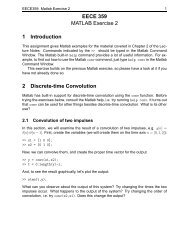Multi-Objective Beamforming for Secure Communication in Systems ...
Multi-Objective Beamforming for Secure Communication in Systems ...
Multi-Objective Beamforming for Secure Communication in Systems ...
Create successful ePaper yourself
Turn your PDF publications into a flip-book with our unique Google optimized e-Paper software.
Constants Γ req and Γ tolk , ∀k ∈ {1,...,K − 1}, are chosen<br />
by the system operator such that Γ req ≫ Γ tolk > 0 and the<br />
maximum secrecy capacity of the system is lower bounded by<br />
C sec ≥ log 2 (1 + Γ req ) − log 2 (1 + max {Γ tol k<br />
}) ≥ 0. P max <strong>in</strong><br />
k<br />
C3 restricts the transmit power to account <strong>for</strong> the maximum<br />
power that can be radiated from a power amplifier.<br />
To facilitate the presentation and without loss of generality,<br />
we rewrite Problem 1 <strong>in</strong> (10) as<br />
m<strong>in</strong>imize F 1 (w, V)<br />
V∈H N t ,w<br />
s.t. C1 – C4, (11)<br />
where F 1 (w, V) =−η eff (w, V).<br />
The second system design objective is the m<strong>in</strong>imization of<br />
the total transmit power and can be mathematically <strong>for</strong>mulated<br />
as<br />
Problem 2 (Total Transmit Power M<strong>in</strong>imization):<br />
m<strong>in</strong>imize F 2 (w, V)<br />
V∈H N t ,w<br />
s.t. C1 – C4, (12)<br />
where F 2 (w, V) =TP(w, V). The design criterion of Problem<br />
2 yields the m<strong>in</strong>imal total transmit power that satisfies the<br />
secrecy QoS requirement of the system. We note that Problem<br />
2 does not take <strong>in</strong>to account the energy harvest<strong>in</strong>g ability of the<br />
idle receivers and focuses only on the requirement of physical<br />
layer security.<br />
In practice, the two above system design objectives are<br />
both desirable <strong>for</strong> the system operator but they are usually<br />
conflict<strong>in</strong>g with one another. In the literature, multi-objective<br />
optimization is proposed <strong>for</strong> study<strong>in</strong>g the trade-off between<br />
conflict<strong>in</strong>g system design objectives via the concept of Pareto<br />
optimality. In the follow<strong>in</strong>g, we adopt the weighted Tchebycheff<br />
method [9] <strong>for</strong> <strong>in</strong>vestigat<strong>in</strong>g the trade-off between Problem 1<br />
and Problem 2.<br />
Problem 3 (<strong>Multi</strong>-<strong>Objective</strong> Optimization):<br />
m<strong>in</strong>imize<br />
V∈H N t ,w<br />
max<br />
j=1,2<br />
{<br />
}<br />
λ j (F j (w, V) − Fj ∗ )<br />
s.t. C1 – C4, (13)<br />
where Fj ∗ is the optimal objective value with respect to problem<br />
<strong>for</strong>mulation j. λ j ≥ 0 is a weight imposed on objective function<br />
j subject to ∑ j λ j =1. In practice, variable λ j reflects the<br />
preference of the system operator <strong>for</strong> the j-th objective over the<br />
others. In fact, by vary<strong>in</strong>g the values of λ j , Problem 3 yields the<br />
complete Pareto optimal set [9], despite the non-convexity of<br />
the set. In the extreme case, Problem 3 is equivalent to Problem<br />
j when λ j =1and λ i =0, ∀i ≠ j.<br />
IV. SOLUTION OF THE OPTIMIZATION PROBLEMS<br />
The optimization problems <strong>in</strong> (11), (12), and (13) are nonconvex<br />
with respect to the optimization variables. In order to<br />
obta<strong>in</strong> a tractable solution <strong>for</strong> the problems, we recast Problems<br />
1, 2, and 3 as convex optimization problems by semidef<strong>in</strong>ite<br />
programm<strong>in</strong>g (SDP) relaxation and study the correspond<strong>in</strong>g<br />
optimality conditions.<br />
A. Semidef<strong>in</strong>ite Programm<strong>in</strong>g Relaxation<br />
For facilitat<strong>in</strong>g the SDP relaxation, we def<strong>in</strong>e<br />
W = ww H , W = W ξ , V = V ξ ,ξ= 1<br />
(14)<br />
Tr(W)+Tr(V)<br />
and rewrite Problems 1–3 <strong>in</strong> terms of W and V.<br />
Trans<strong>for</strong>med Problem 1 (Energy Harvest<strong>in</strong>g Efficiency Max.):<br />
m<strong>in</strong>imize<br />
V,W∈H N t ,ξ<br />
∑<br />
ε k Tr(G k (W + V))<br />
K−1<br />
−<br />
k=1<br />
Tr(HW)<br />
s.t. C1:<br />
Tr(HV)+σsξ ≥ Γ req,<br />
2<br />
Tr(G k W)<br />
C2:<br />
Tr(G k V)+σsξ ≤ Γ 2 tol k<br />
, ∀k,<br />
C3: Tr(W)+Tr(V) ≤ P max ξ,<br />
C4: W, V ≽ 0, C5: ξ ≥ 0,<br />
C6: Tr(W)+Tr(V) ≤ 1, C7: Rank(W) =1, (15)<br />
where W ≽ 0, W ∈ H Nt , and Rank(W) =1<strong>in</strong> (15) are<br />
imposed to guarantee that W = ξww H . Here, Rank(·) is an<br />
operator which returns the rank of an <strong>in</strong>put matrix.<br />
Trans<strong>for</strong>med Problem 2 (Total Transmit Power M<strong>in</strong>.):<br />
m<strong>in</strong>imize<br />
V,W∈H N t ,ξ<br />
1<br />
ξ<br />
s.t. C1 – C7. (16)<br />
Trans<strong>for</strong>med Problem 3 (<strong>Multi</strong>-<strong>Objective</strong> Optimization):<br />
m<strong>in</strong>imize τ<br />
V,W∈H N t ,ξ,τ<br />
s.t. C1 – C7,<br />
C8: λ j (F j − Fj ∗ ) ≤ τ,∀j ∈{1, 2}, (17)<br />
where F 1 = − ∑ K−1<br />
k=1 ε k Tr(G k (W + V)), F 2 = 1 ξ , τ is<br />
an auxiliary optimization variable, and (17) is the epigraph<br />
representation [10] of (13).<br />
Proposition 1: The above trans<strong>for</strong>med problems (15)–(17)<br />
are equivalent to the orig<strong>in</strong>al problems <strong>in</strong> (11)–(13), respectively.<br />
Specifically, we can recover the solution of the orig<strong>in</strong>al<br />
problems based on (14).<br />
Proof: Please refer to Appendix I.<br />
By relax<strong>in</strong>g constra<strong>in</strong>t C7: Rank(W) =1, i.e., remov<strong>in</strong>g it<br />
from each problem <strong>for</strong>mulation, the considered problems are<br />
convex SDP and can be solved efficiently by numerical solvers<br />
such as SeDuMi [11]. Besides, if the obta<strong>in</strong>ed solution <strong>for</strong> a<br />
relaxed SDP problem is rank-one matrix, i.e., Rank(W) =1,<br />
then it is the optimal solution of the orig<strong>in</strong>al problem. Generally,<br />
there is no guarantee that the relaxed problems yield rankone<br />
solutions and the results of the relaxed problems serve as<br />
per<strong>for</strong>mance upper bounds <strong>for</strong> the orig<strong>in</strong>al problems.<br />
Remark 1: Fj<br />
∗ is def<strong>in</strong>ed as the optimal objective with respect<br />
to problem <strong>for</strong>mulation j <strong>in</strong> (17). Whenever we consider<br />
an upper/(a lower) bound of problem j, then Fj<br />
∗ is referr<strong>in</strong>g<br />
to the correspond<strong>in</strong>g upper/(lower) bound value of the orig<strong>in</strong>al<br />
problem j. As a result, if a bound of problem j is considered<br />
<strong>in</strong> Problem 3, then by vary<strong>in</strong>g λ j , the relaxed SDP of Problem<br />
3 provides an approximation <strong>for</strong> the trade-off of the orig<strong>in</strong>al<br />
problems.<br />
9












